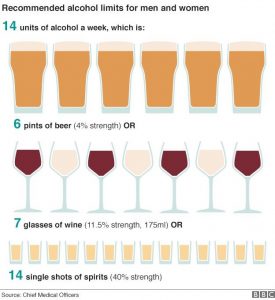Alcohol Intake; The Largest ever Scientific Study on Alcohol gives the Clearest Indication Yet on Drinking Guidelines
Posted by Phil Heler, MD on April 22, 2019Guidelines issued in the UK by our chief medical officers for alcohol intake now mean that we have one of the lowest recommended upper limits for alcohol consumption in the world.
In my last article I mentioned that April is colon cancer awareness month. One of key causes of colon cancer is unfortunately alcohol consumption. The main psychoactive ingredient in alcoholic beverages is of course ethanol and it can have powerful effects on your mood and mental state (which we are all only too aware of). We all know that it reduces our self-consciousness and shyness, alcohol may indeed encourage us to act without inhibition! There are many great quotes about alcohol such as the famous statement by Frank Sinatra who said, “I feel sorry for people that don’t drink because when they wake up in the morning, that is the best they’re going to feel all day.” At the same time, it impairs judgement and promotes behaviour people may end up regretting! This would support another statement by one my favourite authors. Ernest Hemingway’s concluded “Always do sober what you said you’d do drunk. That will teach you to keep your mouth shut.”
A Brief History Of Alcohol
Indeed, mankind has been enjoying alcohol for thousands of years from sources such as fermented grain, fruit juice and honey. Fermented beverages existed in early Egyptian civilisation, and there is evidence of an early alcoholic drink in China around 7000 B.C. The Babylonians worshipped a wine goddess as early as 2700 B.C. In Greece, one of the first alcoholic beverages to gain popularity was mead, a fermented drink made from honey and water. Ancient Greek literature is full of warnings against excessive drinking! At the beginning of the eighteenth century, the British parliament passed a law encouraging the use of grain for distilling spirits. Cheap alcohol flooded the market and reached a peak in the mid-eighteenth century. In Britain, gin consumption reached 18 million gallons and alcoholism became widespread. The nineteenth century meanwhile brought a change in attitudes and the temperance movement began promoting the moderate use of alcohol! Which brings us to current times!
How much do we Drink and Spend on Alcohol?
If you read the Daily Mail this week on 9th April one of the lead articles claims that in the UK, we spend £15 billion a year on alcohol. Now, the Daily Mail is not the most of reliable sources, but this is nevertheless an impressive figure! As sensationalist as ever it then proceeds to mention that we spend £30,000 on alcohol each minute. These headlines might sell newspapers, but alcohol consumption is actually slowly declining in our country!
If we drill down to serious statistics, data from the NHS suggests that between 2005 and 2017 in the UK, there was a fall in the proportion of men who were frequent drinkers (those who drank alcohol on at least five days in the week) from 22% to 12%, and in the proportion of women who did so from 13% to 8%. In 2017 in England, 24% of men said that their average weekly alcohol consumption was more than 14 units but no more than 50 units. 11% of women said that their average weekly alcohol consumption was more than 14 units but no more than 35 units. The latest amended advice on alcohol of course states that both men and men should not consume more than 14 units per week. So, a quarter of men exceed these guidelines in the UK.
Guidelines issued in the UK by our chief medical officers for alcohol consumption now mean that we have one of the lowest recommended upper limits for alcohol consumption in the world. The guidelines update previous limits set in 1995, which indicated that men should be limited to 21 units or less of alcohol per week and ladies at 14 units. We are now one of the few countries that set equal limits for both men and women. Our guidelines, although low compared to other countries, are well supported by scientific research. How do our guidelines compare with our European counterparts (counterparts being a loose term depending on BREXIT!) ?
There a Lack of Agreement Worldwide on Safe Limits of Alcohol Consumption
What is very interesting is that there is a remarkable lack of agreement worldwide about what constitutes an excessive amount of alcohol. In fact, France does not appear to even have any official guidelines at all (remarkable!) , although there are nationwide campaigns suggesting upper limits. A study in the scientific journal Addiction published in April 2016 found among 37 different nations even the standard size of a drink varies by 250%. In the UK and Iceland guidelines are 8g of pure ethanol per unit or standard drink, while in Austria this is set at 20g and some country’s recommendations are even vague. Switzerland advises a standard guideline of between 10-12g per unit (unusual for a country that makes precision watches!), while Luxemburg is extremely precise at exactly 12.8g (very Swiss!).
Our own guidelines mean that men in the UK (at 14 units) are recommended to drink considerably less than those in Ireland (21.2 British units), Denmark (21), New Zealand (19) and much less than the recommended upper limit for men in Spain (a whopping 35g). This has not gone unnoticed. A report in Guardian in 2016 quoted a statement from the Portman Group, which represents the UK alcohol industry. It said: “What is surprising is that the UK is breaking with established international precedent by recommending the same guidelines for men and women. It also means that UK men are being advised to drink significantly less than their European counterparts.”
Clearly nobody drinks alcohol by the gram of pure ethanol. Americans don’t even use metric measures and we insist on keeping alive the imperial pint. Add in concepts like “proof”, “percent alcohol” and “units”, and it is hard to justify chastising anyone who overindulges despite best of intentions. The authors of the study in the Addiction journal we mentioned earlier reached the very sober conclusion of stating “It seems unlikely that everyone is correct.” What we do know is that alcohol damages our bodies. The main problem with alcohol, in terms of our physiology, is that when we digest it we break it down to acetaldehyde, which is a toxic chemical and a human carcinogen. Acetaldehyde can damage both DNA and proteins This in turn generates what we call reactive oxygen species (chemically reactive molecules that contain oxygen), which can cause further damage to yet more DNA, other proteins, and cell membranes in the body through a process called oxidation. It also impairs the body’s ability to break down and absorb a variety of nutrients that may have a protective effect against cancer.
The Largest ever Study gives us the Clearest Indication yet of what Safe Limits are
So, the next question to ask, what does current best evidence suggest? Last year one scientific study gave us the clearest indication yet of where sensible limits lie. Without doubt the most comprehensive piece of best quality research ever published on alcohol consumption appeared in the medical journal The Lancet in September 2018. One commentator suggested it was “most sophisticated global study of the impact of alcohol on human health ever conducted.” This impressive study analysed a huge amount of high-quality data. It offered strong evidence to support recommendations that people drink within relatively low alcohol limits, like those recently introduced in the UK.
Professor Tim Chico, Professor of Cardiovascular Medicine and Honorary Consultant Cardiologist, University of Sheffield, went on record as saying, “It is difficult to accurately estimate the risks of alcohol to health, but the large size and design of this study make its findings both reliable and applicable to countries around the world. It shows that drinking more than 100g of alcohol per week (12.5 units, as 1 unit is 8g of neat alcohol) increases the chance of early death due to all causes”. So, there is our answer.
This study was so comprehensive that it comprised a collaboration of 120 researchers worldwide, from regions including Australia, Europe, Japan, the UK and the US. One key aspect of the study was that it followed the lives of almost 600,000 drinkers. It showed that of this number, people who drank more than 12.5 units (100g) of alcohol a week were likely to die sooner than those who drank no more than this amount. Of the 599,912 people in the study, 40,310 died and 39,018 experienced cardiovascular disease during an average 7.5 years of follow-up. About half of the people in the study reported drinking more than 12.5 units of alcohol a week.
The overall results applied equally to women and men. The researchers estimated that life would be shortened by an average of 1.3 years for women and 1.6 years for men for people aged 40 who drank above the UK weekly limit in comparison with those drinking below the limit. The study also looked at the likelihood of having a range of non-fatal, but potentially life-changing, cardiovascular conditions, including heart attacks, heart failure and stroke. Drinking more alcohol was linked to higher chances of all cardiovascular conditions except heart attacks, where it was linked to a lower chance. However, greater risks from other causes of death outweighed any advantage that might bring. This high-quality study provides further evidence to support the current UK guidelines advising people to drink no more than 14 units a week.
The study emphatically concluded by stating “our results show that the safest level of drinking is none” which, given how deeply embedded alcohol is in present day culture, seems a little stark. These findings certainly directly challenge current health guidelines in many countries worldwide. The good news is that if you follow UK guidelines there is minimal risk. According to statistics expert Professor David Spiegelhalter (who is quoted on the NHS website) “people who drink at the current UK guidelines suffer no overall harm in terms of death rates”. Just for once we might be doing something right in the UK!

